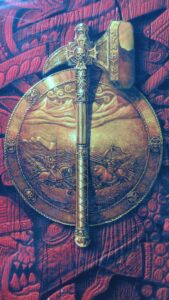Army List Tinkering
 Dipping into Warhammer Fantasy Battles has given me a newfound appreciation for the joys of army list tinkering.
Dipping into Warhammer Fantasy Battles has given me a newfound appreciation for the joys of army list tinkering.
It is a fiddly business in Warhammer, building an army list. Even at the warband scale that is my chosen order of magnitude – a scant 500 and perhaps forty to sixty figures per side. With line troops costing in the 10 point range and each with for or five ‘upgrades’ of one or two points, it can be easy to get bogged down in the accounting. As well, the desire to maximize performance on the field of battle, or to squeeze every last drop of purchasing power out of those 500 points, tempts any would be general down the path of min-maxing. For years such temptations and the aggravation of never feeling entirely satisfied with the army list that results has driven me away from such endeavors.
My recent forays into this oft-maligned appendage of the greater hobby has changed my thinking. Once you’ve established a core to your army, in the context of Warhammer fantasy this usually means your general and wizard and special units, you are left with a few hundred odd points to spend on line troops. And here’s where the fun begins, because there are an awful lot of ways to spend those points. In my experience, this is an iterative process. You purchase a block or two of troops, find out how close you are to the 500 Target, and then add or subtract a few troops. You get closer, you tweak the numbers, you strive to have nice round numbers for your blocks of figures, and eventually land on something that fits the criteria.
 But it’s not the destination from which the pleasure derives, it’s the process. There is something calming about juggling these numbers. It is a meditative practice, and one that reminds me in many ways of writing a short story. There is a larger story to be told with your army, and the structure is built around your leaders and your fancy special characters. Once you’ve built that skeletal framework, you flesh out the army with the line troops. Seeing the character of your army come together in this manner provides a deeper sense of satisfaction and accomplishment than I realized was possible.
But it’s not the destination from which the pleasure derives, it’s the process. There is something calming about juggling these numbers. It is a meditative practice, and one that reminds me in many ways of writing a short story. There is a larger story to be told with your army, and the structure is built around your leaders and your fancy special characters. Once you’ve built that skeletal framework, you flesh out the army with the line troops. Seeing the character of your army come together in this manner provides a deeper sense of satisfaction and accomplishment than I realized was possible.
Having experienced it after several years of intense game at the table time, this is a revelation. It helps to explain the enduring legacy and popularity of the Warhammer family of games.
Not often considered a part of what Featherstone dubbed ‘domestic wargaming’, it makes for a fine way to pass a little time away from the sturm and drang of the dice. You don’t need a gaming partner. You just need a few quiet moments.
It’s not the same sort of satisfaction that derives from more tactile endeavors, like building and painting, but is has a pleasure and a charm all its own.